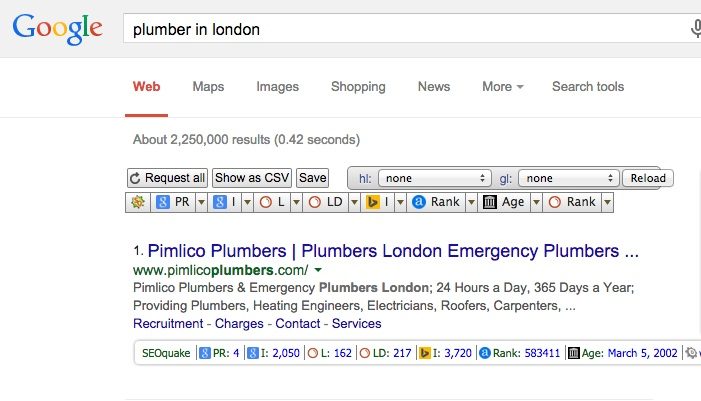
Once you’ve researched the most effective and targeted keywords for your website, how do you go about optimising it – where are the most essential places to put your keywords?
There are a few failsafe areas for inclusion, which I’ve listed below. It takes minutes to update, and can make a real difference to your search rankings.
I’ve listed the best places to put keywords on your website, but don’t forget that keyword SEO only forms a minor part of your overall SEO strategy, which needs to address mobile friendliness, content quality, social media and paid clicks (PPC).
1. Title tags
Title tags are one of the most essential places for keywords as they’re the first thing people see when a website comes up in a web search or on a social media post. On the below example, the blue text starting ‘Pimlico Plumbers | Plumbers…’ is the title tag.
2. Meta descriptions and tags
Like title tags, meta descriptions show up on searches, and therefore need to show the searcher whether or not your page content is relevant for them. In the above example the meta description is the black text underneath the green URL.
Meta tags don’t have much impact on SEO anymore, but you may find it useful as a housekeeping exercise, a record of your keyword focus on each page.
3. H1s and H2s
Headers are a great place for your keywords, as they act as content markers for both search engines and human users. The reason search engines view headers as a key place to review SEO is because of their role in categorising information for users; like humans, search engine crawlers see headers as key information markers for topics. Make sure every page has a different heading tag to other pages, to avoid confusing the search engines.
4. Body text
While you shouldn’t stuff your copy with keywords for the sake of it, naturally incorporating relevant keywords is helpful for SEO. Aim for 2-3 placements per keyword on your average page (or 1-2% keyword density), but if in doubt, avoid clunkily shoehorning in keywords – it can make copy look stilted.
5. Images
Image optimisation is a great way to boost rankings for certain keywords. Place your keywords in the file names of relevant images and in their alt tags (the words that appear when you hover your cursor over an image).
6. URLs
Ensure that every URL is tailored towards the content of its page; avoid long rambling URLs full of random numbers or words, which not only look messy but can also detract from your website optimisation. Keep the URL as short and clean as possible, and include your preferred keywords for that page. When linking internally, use keywords in the anchor text to maximise SEO.
[bctt tweet=”Six essential places for #keywords for optimal website #SEO success”]
Read more
How to plan a basic SEO audit: 5 easy steps
The difference between SEO and PPC: 6 common questions answered






